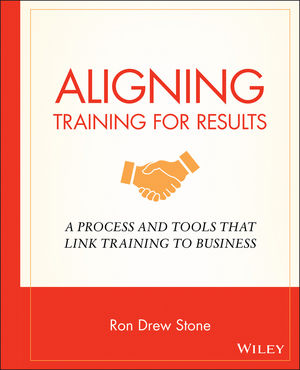Aligning Training for Results: A Process and Tools That Link Training to BusinessISBN: 978-0-470-18175-1
Hardcover
375 pages
October 2008, Pfeiffer
 This title is out-of-print and not currently available for purchase from this site.
|
About This Book iii
Tables, Figures, and Exhibits xv
Web Site Tools xvii
Preface xxi
Introduction xxiii
Audience xxiv
How This Book Is Organized xxiv
Getting the Most from This Resource xxvi
Key Terms Used Throughout the Book xxvii
1 Thinking Performance in the Twenty-First Century 1
Performance Is Our Business 1
Performers Do Have a Choice 2
Viewing Training Through a Different Lens 3
Client-Friendly Performance Framework 4
Business Outcome 6
Execution in the Work Setting 6
Performance Readiness 12
Preferences 14
The Training and Performance Process 14
Top Three Barriers to Performance 16
Summary 17
2 Five Key Factors of Alignment 19
It’s About Results 19
Performance Results Defined 20
Keys to Alignment and Linkage 20
Factor One: Business Outcome Need Is Identified Up Front 22
Factor Two: The Training and Performance Design Is Guided by the Root Cause and Relevant Needs 26
Factor Three: Development and Delivery Are Focused and Linked to the Training and Performance Design 27
Factor Four: Following Delivery, Performers Choose to Execute in the Work Setting 29
Factor Five: Execution Is Linked to One or More Business Outcome Measures 29
Summary 31
3 PAL: The Alignment of Our Processes 33
With a New View Come New Processes 33
Introduction to the PAL Process 34
Phase One: Situational Needs Assessment and Performance Design 36
Step 1: Scope the Project and Utilize Six Signals to Determine Assessment Strategy 36
Step 2: Conduct Detailed Assessment and Analysis and Identify Alternative Solutions 37
Step 3: Administer Situational Risk Assessment and Analysis 37
Step 4: Propose the Solution and Negotiate Performance Alignment Contract 38
Step 5: Go/No Go Solution Decision 38
Phase Two: Design and Development 39
Step 6: Finalize Delivery Design and Strategy for Performance Transfer 39
Step 7: Develop and/or Acquire Focused Performance Solution Components 40
Phase Three: Delivery and Execution 41
Step 8: Implement Pre-Engagement Action 41
Step 9: Deliver Performance Solution and Assess Learning Readiness and Initial Reaction 41
Step 10: Trigger Transfer Strategy and Work Setting Execution 42
Phase Four: Verification and Follow-Up 43
Step 11: Rapid Verification of Results and Follow-Up Action Steps 43
Guiding Principles 43
Summary 43
4 Situational Needs Assessment: Opening the Door 45
A Process with Many Names 45
Getting Started 46
Two Roles for Needs Assessment 46
Proactive Role 47
Client Request Role 48
Client Key Behavior and Suggested Solutions 49
Client Resistance to Our Processes 49
The Initial Meeting: Let the Client Talk 50
Step 1 of the PAL Process: Scope the Project 52
The Six Signals 52
Intake Scope and Alignment Document 64
Summary 73
5 Situational Needs Assessment: The Analysis 75
Step 2 of the PAL Process: Conduct Detailed Assessment and Analysis 75
The Approach 76
The Strategy 76
Sampling 81
Data Collection Methods and Sources 83
Data Collection Methods 83
Data Collection Sources 85
Detailed Analysis 87
Execution Gap Analysis 88
Root Cause Analysis 89
The Acid Test 92
Step 3 of the PAL Process: Administer Situational Risk Assessment and Analysis 92
The Guiding Objectives and Measures 97
Risk Analysis: Assessing the Need for a Transfer Action and Strategy 98
Summary 107
6 Aligning and Proposing the Solution 109
Believe in Your Solution 109
Influencing the Client 110
Step 4 of the PAL Process: Propose the Solution and Negotiate Performance Alignment Contract 110
Educating the Client 113
Negotiating the Solution and the Performance Alignment Contract 119
Evaluation Inquiry 125
Step 5 of the PAL Process: Go/No Go Decision 126
Forecasting the Return on Investment 126
Summary 129
7 Aligning Design and Development 131
The Alignment Continues 131
The Phase Two Handoff 132
Step 6 of the PAL Process: Finalize Delivery Design and Transfer Strategy 134
The Handoff Briefing 134
Step 7 of the PAL Process: Develop or Acquire Focused Solution Components 140
Key Factors for Learning and Performance 141
The Training Manager’s Role 143
Summary 143
8 Aligning Delivery and Execution 145
Enabling the Performer 145
Phase Three of the PAL Process 147
Step 8 of the PAL Process: Implement Pre-Engagement Action 147
Step 9 of the PAL Process: Deliver Performance Solution and Assess Readiness 149
The Delivery 149
Learner Readiness and Initial Reaction 151
Step 10 of the PAL Process: Trigger Transfer Strategy and Execution 153
The Follow-Up Transfer Action and Strategy 153
Developing a Transfer Strategy 154
The Significance of Active Management Reinforcement 158
Summary 159
9 Rapid Verification of Results 161
In The End It’s Results That Count 161
The Evaluation Decision 162
Evaluation Framework 164
Step 11 of the PAL Process: Rapid Verification of Results 167
Step 1: Determine Purpose and Verify Sponsorship for Evaluation 167
Step 2: Develop Detailed Plans for Low-Intensity Rapid Verification Strategy 170
Step 3: Collect and Analyze Readiness Data 179
Step 4: Collect and Analyze Follow-Up Performance Data 179
Step 5: Communicate Findings and Recommend Follow-Up Action 191
Summary 195
10 Cultivating and Sustaining Sponsorship 197
Contribution and Survival 197
Importance of Sponsorship 198
Influencing Sponsorship 199
Channel One: Direct Use Knowledge 200
Channel Two: Casual Indicators 200
Channel Three: Communication of Demonstrated Results 202
The Outside View 203
It’s Time to Stop Doing—and Start Doing 206
Working Our Processes 208
A Few Closing Thoughts 209
Summary 210
Bibliography 211
About the Author 213
Index 215



